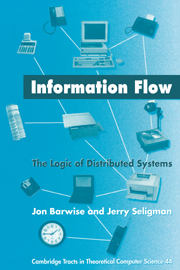20 - Representation
Published online by Cambridge University Press: 05 November 2011
Summary
The concepts of information and representation are, of course, closely related. Indeed, Jerry Fodor feels that they are so closely related as to justify the slogan “No information without representation.” Though we do no go that far, we do think of the two as intimately connected, as should be clear from our account. In this lecture, we sketch the beginnings of a theory of representation within the framework presented in Part II. We have three motives for doing so. One is to suggest what we think such a theory might look like. The second is to explain some interesting recent work on inference by Shimojima. The third is to show that Shimojima's work has a natural setting in the theory presented here.
Modeling Representational Systems
When we think of information flow involving humans, some sort of representational system is typically, if not always, involved: Spoken or written language, pictures, maps, diagrams, and the like are all examples of representations. So representations should fit into our general picture of information flow.
A theory of representation must be compatible with the fact that representation is not always veridical. People often misrepresent things, inadvertently or otherwise. For this reason, we model representation systems as certain special kinds of information systems where unsound logics can appear. We begin with our model of a representational system.
- Type
- Chapter
- Information
- Information FlowThe Logic of Distributed Systems, pp. 235 - 242Publisher: Cambridge University PressPrint publication year: 1997



